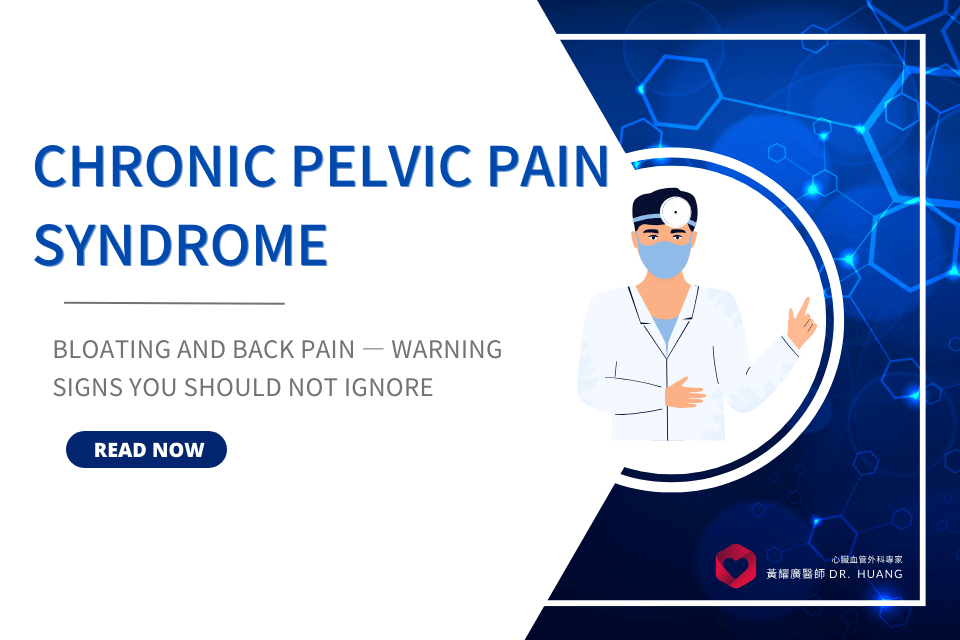Immediate Treatment for Chronic Wounds
Why Your Wound Won't Heal?
What Does It Mean When Your Wound Won't Heal?
Patients with chronic wounds often only realize there might be an underlying vascular problem when they notice that the wound is not healing and worsens to the point of exposing the bone or even developing sepsis during dressing changes.
However, at this point, the best time for recovery has usually passed. For chronic foot wounds, it may eventually lead to extensive amputation or disability.
How are chronic wounds usually treated?
When treating chronic foot wounds, unlike other units, we first confirm whether there are any abnormalities in the foot's circulation.
After optimizing blood vessel conditions at the appropriate time, we then perform debridement and other subsequent procedures to preserve the maximum limb function.

DR. Huang's Extensive Experience
- Chief of Cardiac Surgery at Chang Gung Memorial Hospital, Chiayi
- Subspecialty Director of Thoracic Surgery, Taiwan Society of Thoracic and Cardiovascular Surgery
- Subspecialty Director of Vascular Surgery, Taiwan Society of Vascular Surgery
Common Symptoms of
Chronic Wound
REASON

Peripheral Vascular OcclusionArterial Wounds
Treatment primarily focuses on vascular surgery (angioplasty and stenting).

Venous Reflux or Venous OcclusionVenous Wounds
Complex venous wounds, treat with stenting and thrombus removal.

Diabetic FootMixed Wound
Mixed wound, healing difficult, common in diabetics.

Dialysis FistulaChronic Wound
Can cause chronic wounds, consult cardiovascular surgeon.
Do You Have a Chronic Wound?
Chronic wounds can cause a wide variety of symptoms. The following lists several classifications of chronic wounds and their common symptoms.
Click for more information.
Sudden Appearance of Small Blisters near the Toes
This is an early sign of skin ischemia and necrosis, often manifested as purple discoloration and blisters.
If not treated promptly, bacterial infection can occur, leading to pus, drainage, and sepsis.
Wound Becomes Deeper and More Painful Despite Frequent Dressing Changes
While changing wound dressings can cause some discomfort, increasing pain or redness around the wound may indicate worsening of the wound.
Unexplained Blackening or Redness of Toes and Feet
Redness and blackening of the toes are serious signs of ischemic foot changes and require prompt medical attention to determine the cause and prevent lifelong disability.
Recurrence of Previously Treated Foot Wounds
The most common causes of wound recurrence include failed smoking cessation, restenosis of foot blood vessels, and failure to follow up for regular check-ups and medication.
If a wound recurs, a prompt follow-up visit should be scheduled to identify the underlying issue.
Procedure for Chronic Wound Treatment
-
 1
1Wound Assessment
Conduct basic arterial and venous examinations.
-
 2
2Advanced Examinations
If necessary, arrange for "advanced vascular exams" and "CT angiography."
-
 3
3Drainage and Debridement
Stabilize blood flow, then drain & clean wound. Schedule surgery for deeper debridement.
-
 4
4Negative Pressure Wound Therapy
After cleaning & stabilization, use special dressings & NPWT to promote healing.
-
 5
5Post-operative Care
Perform wound debridement and dressing evaluation during the recovery phase.

Chronic Wounds FAQ
Chronic wounds can give rise to many complex situations. Dr. Huang will provide answers to common questions.
How is a chronic wound defined?
Many people experience persistent non-healing small wounds but are unsure if they are chronic. A chronic wound is defined as a skin defect that has not healed for more than four weeks.
Often, patients only seek medical attention when the wound has not healed for three or six months.
What are the three main types of chronic wounds?
The three main types of chronic wounds are:
1. Venous Ulcers: These occur due to poor blood circulation in the veins, often in the legs.
2. Arterial Ulcers: Resulting from inadequate blood flow through the arteries, commonly associated with peripheral artery disease.
3. Diabetic Foot Ulcers: These are a common complication in people with diabetes, often due to neuropathy and poor circulation.
Is debridement also suitable for treating diabetic wounds?
The purpose of debridement is to control infection. After debridement, adequate blood flow must be present to promote circulation, antibiotics must be used to control infection, and blood sugar control and smoking cessation are necessary.
The treatment principle for diabetic foot wounds is similar, but more factors need to be considered.
Do you only treat wounds on the limbs?
We also treat chronic wounds in various parts of the body at Chang Gung Memorial Hospital, but wounds involving the exposure of gastrointestinal organs are not recommended for treatment at the vascular wound center.
Does wound debridement require anesthesia in the outpatient surgery?
In principle, chronic wound debridement is performed with local anesthesia. Patients requiring general anesthesia will be arranged for surgery in the operating room.
Besides debridement and dressing changes, what other treatments are available?
We will provide medication recommendations and apply for the use of certain special medical devices.
What is the main content of reconstructive surgery?
For chronic wound reconstruction, negative pressure wound closure devices and skin grafting can address most tissue defects.
In a small number of patients, flaps or microsurgery may be required for reconstruction.
How to make a chronic wound heal faster?
What helps chronic wounds heal faster? Here are some common strategies:
Keep the wound clean and moist.
Follow your doctor's prescribed treatment.
Maintain a healthy diet and avoid smoking.
Manage underlying conditions (e.g., diabetes).
You can also consult with DR. Huang for personalized advice.
How to prevent chronic wounds?
1. Regularly check your feet for any signs of injury.
2. Control blood sugar levels.
3. Maintain healthy skin.
4. Wear comfortable shoes.
5. See a doctor promptly for any cuts or sores.
Schedule an Appointment at Cardiovascular Department
Many people with persistent non-healing wounds are unsure which department to consult. Cardiovascular surgery is the most appropriate choice in such cases.
We will first optimize the vascular condition to accelerate wound healing and reduce the risk of extensive amputation. With a simple medical process, the timing of vascular intervention can be determined during the same outpatient visit, providing a quick and efficient solution!
Identify Underlying Vascular IssuesSeize the Golden Opportunity for Wound Healing
Professional Advantages
Reliable Surgical Quality
The surgical team is stable, with comprehensive pre-consultation and post-operative education services available online.

Appropriate Patient Distribution
Chronic wounds are treated in an outpatient unit (wound center), allowing for appropriate separation from general patients, improving efficiency and reducing hospitalization needs.
Vascular Adjustment before Debridement
First, we confirm whether there are any abnormalities in the foot's circulation.
After adjusting the blood vessels to the best condition, we then perform debridement to preserve the maximum limb function.Advanced Arterial and Venous Wxaminations
Peripheral arterial angiography and angioplasty, magnetic resonance venography, for more detailed examinations.
Simple Medical Process
The timing of vascular intervention can be determined during the same outpatient visit, providing a quick and efficient solution for wound treatment.
Negative Pressure Wound Reconstruction
Negative pressure therapy promotes the growth of wound granulation tissue and is a recognized treatment method in international medical institutions.
MedicalNews
Advantages of Negative Pressure Therapy
Negative pressure therapy involves placing a sponge-like dressing over a debrided wound and applying negative pressure to promote wound healing.
Additionally, hemoglobin extract, which increases local oxygen levels, or hyperbaric oxygen can be used to enhance wound healing and prevent amputation.





